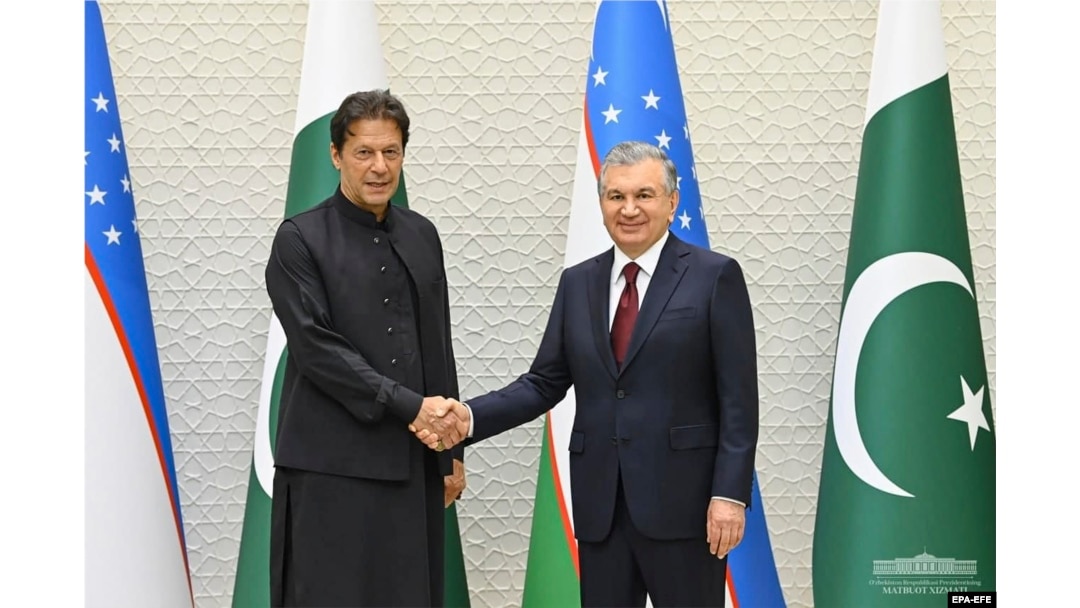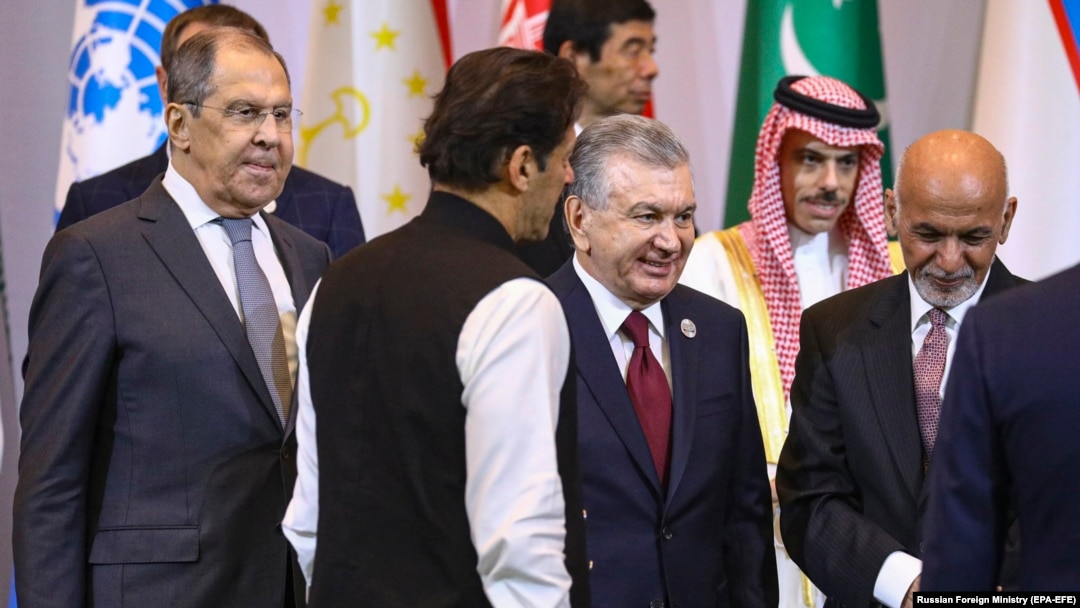Central Asia has long advertised itself as the crossroads of the Eurasian continent -- a region that, with development, could be an important transit hub for shipping goods from east to west and from north to south.
The Asian Development Bank’s Central Asia Regional Economic Cooperation (CAREC) trade corridors and China’s Belt and Road Initiative (BRI) have helped extend Central Asia’s east-west connectivity.
The CAREC maps also envision trade corridors to the south via Afghanistan. But such links remain tenuous.
Nevertheless, calls for trade routes via Afghanistan that would connect Central Asia to Pakistani and Indian ports on the Arabian Sea are not forgotten.
Judging by the attendance at a July 15-16 conference in Tashkent, regional players still see potential in the proposed routes.
Although the conference was independent of CAREC and BRI, some infrastructure initiatives overlap with both projects.
New Optimism?
The major obstacle hindering the projects is instability in Afghanistan.
With Taliban fighters recently seizing control over large swaths of territory, linking Central Asia and South Asia via Afghanistan appears less likely than ever.
Still, other factors that have changed amid the ongoing fighting have given some reason for new optimism.

Uzbek President Shavkat Mirziyoev (right) meets with Pakistani Prime Minister Imran Khan in Tashkent on July 15.
The venue of the July conference, the capital of Uzbekistan, was symbolic of one of those changes.
During the years Islam Karimov was president, Uzbekistan became increasingly isolationist.
While Uzbek officials lamented being in one of only two the world’s double-landlocked countries, they still cut back ties with their immediate neighbors in Central Asia.
President Shavkat Mirziyoev pledged to improve relations with other countries after Karimov died in 2016. He said he would start with the other Central Asian nations.
According to an article sponsored by Uzbekistan’s embassy in Japan ahead of the recent conference, circulation of goods nearly doubled among Central Asian countries during the period from 2017 to 2019 -- rising from $2.7 billion to $5.2 billion.”
That change is not surprising when one considers that Uzbekistan borders all other Central Asian countries, as well as Afghanistan.
A closed Uzbekistan had hurt many countries in the region. Now, the opening of Uzbekistan by Mirziyoev already has benefited regional trade.
The same article also argued about the importance “for the states of Central Asia to ensure that they take politically coordinated steps aimed not only at intensifying regional economic cooperation, but also reaching a new, interregional level of interconnectivity.”
That is an important distinction as it suggests trade routes south from Uzbekistan could be a conduit for Central Asian trade with South Asia.
Such regional cooperation makes Central Asia more attractive to potential trade partners not only in South Asia but also in the Middle East, Africa, and Southeast Asia. That’s because they could use the links between Arabian Sea ports and Central Asia.
A Central Asia-South Asia trade network also could connect to other networks much farther afield.
The Importance Of Khan
Meanwhile, another development at the Tashkent conference is being seen as an encouraging sign for Central Asia-South Asia connectivity -- the attendance at the event of Pakistani Prime Minister Imran Khan.
Khan, the first foreign leader to arrive at the event, met with President Mirziyoev before the conference. By all accounts, he was warmly greeted by Uzbek officials.
That marks a sharp contrast to the late 1990s.
In May 1997, during an Economic Cooperation Organization meeting in Ashgabat, Turkmenistan, Karimov called for then-Pakistani Prime Minister Nawaz Sharif to publicly declare Islamabad would no longer support the Taliban in Afghanistan.
The Tashkent conference showed that great interest remains in realizing a Central Asia-South Asia trade corridor network.
Sharif, as head of one of the only countries in the world at the time that recognized the Taliban as Afghanistan’s official government, refused to do so.
In August 1998, when Pakistan's then-Minister of State for Foreign Affairs Mohammad Kanju visited Uzbekistan and Tajikistan, neither Karimov nor Tajik President Emomali Rahmon would meet with him.
Uzbek-Pakistani ties have slowly warmed since then. But Khan’s visit marks a high point in bilateral relations between the two countries. And since Pakistani ports are the closest southern ports to Central Asia, it is important that Uzbek-Pakistani ties be solid.
The Pakistani newspaper The Express Tribune predicted that agreements during Khan’s visit should “open doors for increasing Pakistan’s exports to Uzbekistan, while harnessing the potential of a $90 billion market in Central Asia.”
A statement by the Uzbek Embassy in Japan ahead of the Tashkent conference noted the planned attendance by “more than 250 participants from over 40 countries and international organizations.”
In addition to Pakistan’s prime minister, they included Afghanistan’s president, as well as the foreign ministers of Kazakhstan, Kyrgyzstan, Tajikistan, Turkmenistan, China, Russia, India, Bangladesh, Saudi Arabia, Kuwait, Turkey, the Maldives, and other countries.
They also included UN Secretary-General Antonio Guterres, EU foreign policy chief Josep Borrell, and a delegation from the U.S. State Department.
A Central Asia-South Asia Network
There is no doubt that reliable Central Asia-South Asia connectivity would benefit many countries.
A report from UzDaily.com notes that Russia has been moving forward with its north-south transport corridor.
Part of that corridor would connect the Baltic countries and Russia to India via railway lines and ports in Iran and Pakistan -- less than half the distance of the sea routes from northeastern Europe to India.
Russia’s north-south trade corridor also would avoid the increasingly congested Suez Canal.
The Iranian port of Bandar Abbas is currently the quickest option for businesses in Central Asia to trade with partners in the Indian Ocean region.
Tajik Foreign Minister Sirojiddin Muhriddin (left) speaks with the special U.S. envoy to Afghanistan, Zalmay Khalilzad, at the Central and South Asia 2021 conference in Tashkent on July 16.
A modest amount of goods to and from Central Asia also is currently transported through Iran by rail through Turkmenistan or by ship via Kazakhstan’s Caspian ports.
The UzDaily notes that the construction of a railway line from Mazar-e Sharif thru Kabul to Peshawar in Pakistan would reduce Russia’s north-south route by up to 600 kilometers.
That proposed railway was a key topic in the recent talks between Pakistan’s prime minister and Uzbekistan’s president -- even though, under the current security situation, construction of such a route seems impossible.
Similar reductions in distance and shipping times apply to China’s trade with South Asia and East Africa.
Again, Afghanistan is the major obstacle to this Central Asia-South Asia network.
Other concerns include the lack of unified railway track and the absence of unified standards for shipping documents.
Still, the Tashkent conference showed that great interest remains in realizing a Central Asia-South Asia trade corridor network.
That provides added incentive for countries in both regions to work on bringing stability to Afghanistan and reaping the benefits of trade connectivity.


